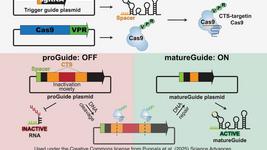New paper out today: DIAL system fine-tunes gene expression levels
Large-scale CRISPR screening tools excel at identifying genes with linear relationships to phenotypes, but often miss regulators with nonmonotonic dose-response curves. The DIAL promoter editing system tackles this gap by enabling fine-scale titration of expression from a single promoter.
DIAL places DNA spacers of varying lengths between synthetic zinc finger transcription factor binding sites and a minimal promoter, flanked by recombinase recognition sites (loxP or VloxP). When Cre or VCre recombinases are activated, they excise these spacers, bringing the binding sites closer to the promoter and shifting expression to a higher setpoint.
By nesting multiple recombinase sites, researchers created promoters generating four distinct, unimodal expression levels from a single DNA sequence – critically, without the binary (all-or-nothing) distributions that plague many inducible systems. The setpoints proved robust across varying transcription factor concentrations and remained stable through cell division.
The team successfully delivered DIAL via lentivirus to mouse embryonic fibroblasts and human induced pluripotent stem cells. It used it to control HRasG12V expression during direct conversion to induced motor neurons, demonstrating that fine-scale changes in expression drove different rates of cell fate transition.
The study was conducted by Sneha Kabaria and Kate Galloway from the Massachusetts Institute of Technology. It was published in Nature Biotechnology today, 13 October 2025.
To get more CRISPR Medicine News delivered to your inbox, sign up to the free weekly CMN Newsletter here.
Tags
CLINICAL TRIALS
Sponsors:
Base Therapeutics (Shanghai) Co., Ltd.
Sponsors:
Base Therapeutics (Shanghai) Co., Ltd.







